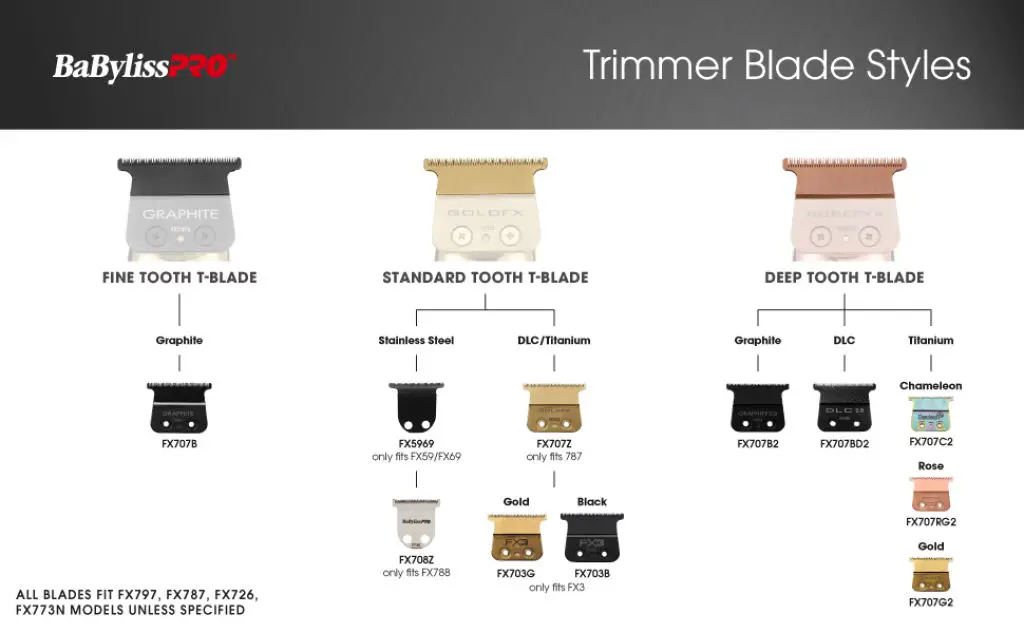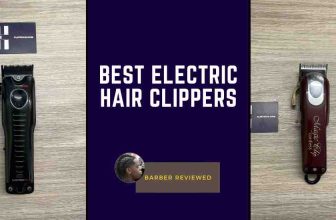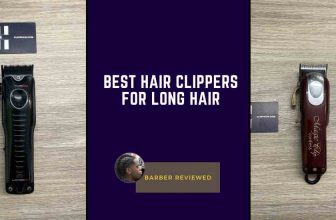
As a user of Babyliss trimmers myself, I know how important it is to understand the Babyliss trimmer blade differences.
By knowing the distinctions, we can make the most informed decision on which T blade will be best suited for our individual needs and grooming preferences.
In this article, we’ll through that exactly and I’ll show you how I differentiate each blade to know exactly which one I want on my trimmer.
Babyliss Trimmer Blade Differences
Babyliss is known for its high-quality grooming products and its trimmer blades are no exception.
They offer different types of blade designs, such as a fine tooth, deep tooth, standard tooth blades, then a bunch of coating and materials.
But the best way to understand Babyliss blades would be to first, understand the type of blade you’re after (which is the blade mentioned above), then you want to decide what, material or coating you want on your blade.
When you think about it like that, that’s when you can start differentiation between the blades.
And if you want to cover the best Babyliss trimmer blades check out this article:
Best Babyliss Trimmer Blade (Upgrade Your Trimmer Game)
Babyliss Pro FX Series
Now, Babyliss does have a wide range of trimmer models, but their most popular line would be their Fx line (the torchlight shape trimmers).
But if you want the specifics of your trimer the: fx797, fx787, fx726, or fx773n, the blades mentioned below, will fit your trimmers.
Now as I said earlier these are the main types of blades that come available to the Babyliss models are below.
This is the physical property of the T blade, not the material or coating.
- FX707Z Standard blade: This blade works best for versatile use, suitable for all-around trimming, the teeth have a depth of 1.6mm and it covers all hair types
- FX707B Fine-tooth blade: I prefer this blade for precise line-ups, the teeth are narrower and have a depth of 1.3mm, great for detailed work such as hairlines.
- FX707G2 Deep tooth Blade: This blade has the longest depth at around 2mm and is best for bulk hair removal.
Now, that you (what) type of blade you are after (i.e. its physical property), now you choose which material you want on that blade… that’s what will ultimately differentiate each blade.
We’ll go through this next.
Blade material Differences
Now we’ll go over the material a blade can come in and what that offers.
Stainless Steel
A high-strength metal known to have great cutting power, semi-durable, and resistant to rust, it’s hard but not to the level of the titanium or DLC blades, it is a pretty standard coating for blades.
Graphite
When it comes to graphite, the blade isn’t actually made of graphite but is coated in it. So the blade could be stainless steel but the graphite covers it.
So what does graphite offer? Graphite gives the blade more durability, the graphite itself does wear against each other as much as a fresh stainless steel blade, due to this the blade has lower temperatures and will just last longer (due to less friction).
DLC
Now, DLC, a DLC-coated blade is kind of like graphite, it too coats the blades and all around will have lower blade temperature than a regular stainless steel baldes, but this blade excels in wear resistance meaning, even if you abuse this blade (which you shouldn’t) naturally, the properties of the coating are great at resisting the t blade and cutting blade constantly interacting.
Naturally, if you maintain your trimmers, they won’t wear anyway but for those that don’t really maintain their trimmers or “forget” this coating is there to give you some extra legs.
Titanium
Titanium is just hard and tough. They’re the most durable blade and stay sharp the longest. The titanium blades from Babyliss are also hypoallergenic meaning they (shouldn’t) cause an allergic reaction and are good for sensitive skin
Titanium/DLC
Then lastly… you have you have Dlc + Titanium.. this is a naturally strong blade, with great wear-resistant properties.
The blade is titanium and coated with Dlc.. some dub it the ultimate type of blade but you’d have to get it to decide yourself.
Which model allows which blade?
So now you know you know the types of blades: Fine tooth, standard tooth, and deep tooth.
And you know all the material and coating that can fit on those model blades .. but what you must also know is that not every coating/ blade material can go on any blade type.
Take for example… In the fine tooth blade line, you can only have the graphite coating/material for that type of blade.
Babyliss doesn’t do a titanium fine tooth blade for example.
In the standard tooth line, you can have Dlc/titanium (the super blade combination I mentioned earlier).
But be aware, the fx703g and the fx703b blade which have the Dlc/titanium coating, will only fit the Babyliss fx3 (this model is built differently compared to the others).
Then in the deep tooth blade types is where you have the most flexibility.
For example in the deep tooth line, you can have graphite, DlC, and titanium blade independently.
this image illustrates this well:

Conclusion
In this article, we went over Babyliss trimmer blade differences.
We went over what makes each blade type different and how the coating and material you have on a blade are what truly make each blade different.
If you found this article helpful, check out other articles on this topic below.











